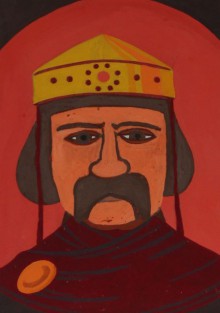If you still think that a museum means boring exhibits in dusty showcases and you know the history of your country from the school curriculum and TV news, be sure to visit “Cross and Trident” and you will see that the past, the present, and the future, are forming a single, living, and pulsating tissue of our life.
The project’s main idea is to show the continuity of statehood since the times of Prince Volodymyr, the baptizer of Rus’. A team of museum people has put up an exposition of more than 300 items gathered from various sources: the holdings of the Museum of Kyiv’s History, the National Art Museum of Ukraine, the Institute of Archeology, the Sheremetievs’ Museum, the private collections of artists Halyna Sevruk and Oleksii Liubimov, as well as from the archive of the Prakhov family.
The exposition begins with the archeological items that date back to the times of Volodymyr the Great’s princedom (980-1015). To show a very important role of the prince’s armed retinue (druzhyna) in defending the homeland, the museum displays the authentic armor and gear adorned with heraldic symbols, including a beautiful bone reliquary with a trident, a bludgeon, and a bident’s scabbard tip. Next to this hang a huge map that delineates the boundaries of Kyiv’s territories in the 11th-13th centuries and a map of Kyivan Rus’ with settlements of the Polochans, Severians, Volhynians, and Uliches, as well as a detailed reconstruction of “Volodymyr’s town.” The central glass case shows, much to the utter delight of the visiting young boys, a very genuine weapon of that time – an iron sword, fragments of horse bridles’ decorations, and massive princely finger-rings.
The exhibit represents, interestingly and in minute detail, the history of temple construction in Kyivan Rus’ on the example of the finds of the Tithe Church and other temples of Kyiv’s inner fortress. Of particular value are photos of churches and cathedrals that have not survived to this day (blown up by the Bolsheviks or lost during WWII), for it is the only documentary image of them now. Next to this, in a glass case, we can see a little icon of the Okhtyrka Mother of God, a cypress cross, and a wooden rosary. The role of Prince Volodymyr the Baptist is brilliantly illustrated by Fyodor Shavrin in the book Vladimir the Red Sun from the collection of the National Art Museum of Ukraine. But what immortalized his memory the best is Saint Volodymyr’s Cathedral built in the second half of the 19th century by Kyiv’s architect Ivan Shtrom. When the construction was over, the temple’s walls remained untouched for three years – they were being dried up to make the paint hold fast. Then, under the guidance of St. Vladimir University Professor Adrian Prakhov, the cathedral was painted over by such well-known artists as Prof. Viktor Vasnetsov, Pavel Svedomsky, Wilhelm Kotarbinsky, Mikhail Nesterov, Nikolai Pimonenko, and Andrey Mamontov, while Mikhail Vrubel created the braided-wheat ornaments at the entrance to the cathedral’s middle nave. The Prakhov family’s archives have essentially complemented the exposition, and the spectator will see the unique photos of artists at work against the backdrop of frescoes.
Also of interest are the watercolor portraits of principality-era figures painted by the historian and archeologist Mykhailo Braichevsky who devoted all his lifetime to studying the history of Kyiv. The original ceramic works by the Sixtier Halyna Sevruk (“Prince Askold,” “Princess Olha,” “Prince Volodymyr,” “Illarion,” “Daniel of Galicia,” “Griffon,” “A Chronicler,” “An Ancient Rus’ Warrior”) bring to the present day the images of the most important figures in Ukrainian history from the era of Prince Volodymyr to modern times. Incidentally, visitors will see not only ceramics and watercolors, but also the genuine paper money of the UNR and the Ukrainian State with a pictured trident, which are based on sketches by Heorhii Narbut, Vasyl Krychevsky, and other artists.
The name “Cross and Trident” fully reflects the exposition’s essence because these things have been the central symbols of clerical and secular power in our more than a thousand-year-long history.
Come and see the exhibit until September 29 and tell your children this country’s history.








